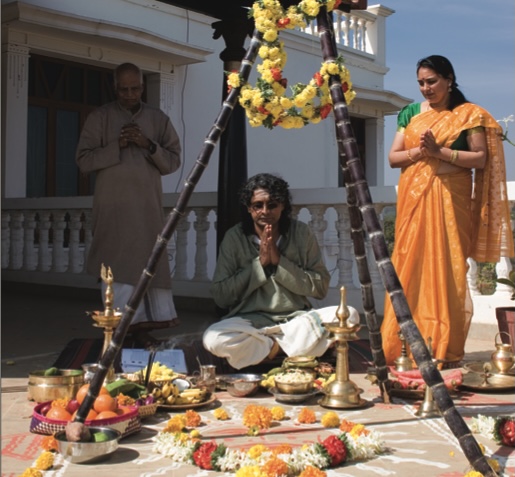As a Hindu woman living in silicon Valley, USA, I found myself challenged by the difficult tasks of explaining a tradition, accurately relating a mythological tale, and celebrating our festivals the right way with my American child and friends. I needed a resource that would help me with the stories, recipes and prayers that make up a Hindu festival,” confides Soumya Sitaraman in the introduction to Follow the Hindu Moon. Such motivation prompted long trips to India filled with careful scriptural research and intimate interviews with elders and priests, resulting in this two-volume set explaining the what, where, when, why and how of every South Indian festival observed by the people of Andhra Pradesh, Karnataka, Kerala and Tamil Nadu. Wow.
Soumya describes her books as “a cultural lifeline for the growing number of Hindus scattered across the globe.” She explains, “I seek to provide the reader with a means of applying this traditional ideology in contemporary life.”
Book 1: Celebrate explains the meaning and significance behind each festival, recounts the stories behind it and offers detailed walkthroughs for setting up and celebrating it. There are shopping lists, preferred flowers, cooked offerings, feast menus, auspicious things to do and when, prayers to offer and how to organize it all, complete with checklists and cheat sheets–all presented in great detail to assist the family in their celebrations. The book also contains a start-to-finish guide for performing puja, from simple to elaborate, including the meaning behind every procedure.
Book 2: Understand presents an overview of the cosmology behind the Hindu festival calendar and culture, the Gods who are praised, and detailed guides to festoons, decorations and etiquette. It includes over 150 pages of recipes for traditional festival dishes and sweet and savory offerings. No question is left unanswered. The level of detail is astounding, whether it be how to draw a kolam or weave a garland, what to wear for each celebration, what mantra to chant and when, or how a festival lunch in Andhra Pradesh differs from one in Tamil Nadu. Each volume has its own index and a thorough glossary, defining all non-English words in simple terms.
The author concludes, “Contemporary lifestyles are hectic and often isolated, especially as more individuals are adopting the modern nuclear family unit. The community that was the mainstay of culture is fast disappearing into a virtual one where individuals seek to make their connections throught the Internet. Globalization and fragmentation of large families have resulted in a disconnect. [The channels traditionally used] to impart cultural and ritual expertise to succeeding generations are hindered by physical distance, new ideologies and an unforgiving pace of life. While people continue to celebrate festivals with great gusto and elaborate attention, many of the meaningful elements of a traditional celebration are lost, especially when one is removed from the warmth and knowledge of the parent community one belongs to.” Soumya Sitaraman has provided excellent documentation of these traditions in a simple, accessible format which will help modern families integrate ancient customs into everyday life. Infused with a warm, personal tone, Follow the Hindu Moon is a tribute to every family that worships together.
Follow the Hindu Moon, a Guide to the Festivals of South India, by Soumya Sitaraman, Random House India. rs. 3,150; 908 pages http:/www.hindumoon.com [http:/www.hindumoon.com]
A TRIBUTE TO HINDUISM
From time immemorial, India has been synonymous with spiritual knowledge and has attracted numberless philosophers, poets, historians, scientists and travelers. Some have been able to physically visit her sacred land, while others have imbibed translations of her rich and imaginative literature from afar. Though political leaders have led the world into wars and imperialism, ancient India’s spiritual wisdom has provided an uplifting counterpoint, profoundly influencing Western scientific and imaginative thought, arts and literature. Scientists, scholars, poets, writers and philosophers have paid the highest compliment to India’s genius in metaphysics, religion, art, language and culture by incorporating many of her ideas and theories into their own work. A Tribute to Hinduism by Sushama Londhe is a rich collection of Western and Eastern thinkers’ inspired gems on Hinduism and India.
A Tribute to Hinduism, by Sushama Londhe, Pragun Publications, New Delhi, India. rs. 895; 550 pages http:/www.atributetohinduism.com [http:/www.atributetohinduism.com]
POEMS FOR SIVA
The seventh-century mystic, poet and yogini known as Karaikkalammaiyar,, “Mother of Karaikkal,” is one of the 63 Saivite Tamil saints, nayanars, codified in Sekkilar’s 12th-century Periyapuranam. Of the few nayanars who gave the world a written legacy, she was perhaps the earliest; her poems mark the start of the literature later arranged into the highly venerated Tirumurai. In Poems for Siva, Peter de Bruijn brings forward Karaik kal ammaiy ar’s works in Tamil, with English translation, poignantly describing, praising and supplicating Siva. Over 35 color and black-and-white photographs are included, showing Indian, Sri Lankan, Khmer and Southeast Asian sculptures and paintings of Siva dating from the 6th to 17th centuries.
Poems for Siva, by Peter de Bruijn, Dhyani Publications, Rotterdam, the Netherlands. Euro 35 (black and white edition Euro 25); 106 pages. http:/www.dhyani.nl [http:/www.dhyani.nl]
